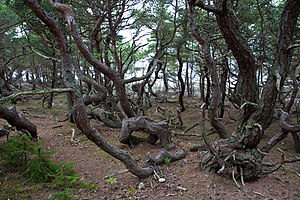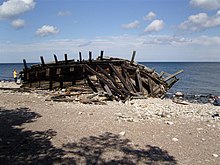Trollskogen
|
Trollskogen
|
|
| location | Sweden |
| surface | 275 ha |
| WDPA ID | 173303 |
| Geographical location | 57 ° 21 ' N , 17 ° 7' E |
| Setup date | 1998 |
| administration | Kalmar County Provincial Administration |
Trollskogen (en: magic forest) is a nature reserve on the northern tip of the Swedish Baltic Sea island of Öland .
location
Trollskogen is part of the Böda Ecopark and is located on Öland's northeastern headland. The Baltic Sea borders in the north and east and the Grankullaviken Bay in the west . The nature reserve Bödakusten östra lies to the south.
Three hiking trails run through the Trollskogen. The shortest (0.9 kilometers) only runs through the southwestern part of the area. Another hiking trail (2.7 kilometers) leads along the coast to Grankullaviken Bay and through the inner part of the Trollskogens. The longest route (4.5 kilometers), unlike the two previous ones, is not wheelchair accessible, and leads along both coasts of the peninsula. The starting point for all routes is a Naturum center in the south of the Trollskogens, where information is provided about the Öland landscapes.
nature
The specialty of the Trollskogen, to which it owes its name, are very old crooked trees. In the vicinity of the stone beaches of the Baltic Sea, the often strong wind ensures the unusual growth of the unprotected trees. In the interior of the Trollskogen, a coniferous forest dominated with pines, some of which were 200 years old . Dead trees stand as dead wood, fallen trees lie on the ground. The unspoilt impression is reinforced by overgrown ivy . The beach to the Grankullaviken bay is, unlike the Baltic Sea beaches, characterized by open meadows that serve as pastures.
The individual old oaks standing in the pine forest are striking . They are the remainder of the earlier landscape, which was characterized by more grazing, in which there was only a light forest dominated by oaks.
In contrast to parts of the southern Bödakuste östra region, the Trollskogen is rich in species. The grazing that still takes place in parts of the area today ensures lighter sections of the forest in which different plants and animals find a habitat. So grow in the Trollskogen Hunds-Kerbl (Anthriscus caucalis M. Bieb.) Winterlieb (Chimaphila umbellata (L.) WPC Barton), sword-leaved wood bird , salt mugwort (Seriphidium maritimum (L.) Poljakov), Pachyphiale carneola , Sphinctrina turbinata and Calicium abietinum .
The old pines and oaks and especially the dead trees offer a habitat for a wide variety of insect species.
Attractions
Near the east coast is the particularly old and overgrown oak Trolleken ( German magic realm ). It is one of the oldest oaks in Öland.
In the Trollskogen there are also legacies of human activity in historical and prehistoric times. There are around 15 burial mounds and stone settings of prehistoric burial sites on the area of the nature reserve . Also noteworthy is the Jaktmuren from the 16th century running south . On the Baltic coast lies the wreck of the schooner Swiks , which was stranded on the banks of the Trollskogens during a storm at Christmas 1926.
literature
- Trollskogen "Magic Forest" , Provincial Government of Kalmar Province, Kalmar 2008
Web links
Individual evidence
- ↑ , Anthriscus caucalis M. Bieb. In: the virtuella floran. Retrieved January 8, 2012 (Swedish).
- ↑ Chimaphila umbellata (L.) WPC Barton. In: the virtuella floran. Retrieved January 9, 2012 (Swedish).
- ↑ Seriphidium maritimum (L.) Poljakov. In: the virtuella floran. Retrieved February 9, 2012 (Swedish).





